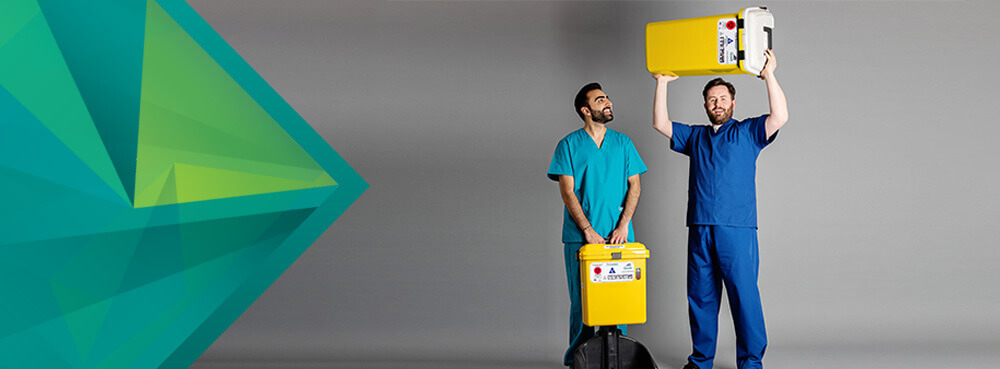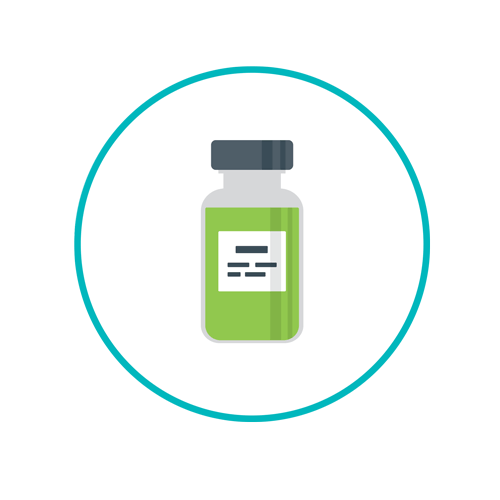Chemotherapy Waste Disposal Regulations

When it comes to chemotherapy waste disposal regulations, every healthcare provider or those who are part of the waste management chain at your facility should be able to define exactly what chemotherapy waste is, how to handle it, and ultimately, how to properly dispose of it.
Chemotherapy waste (including trace chemotherapy waste) and components used in treatments are produced during preparation and/or delivery of chemotherapy to patients. However, not all waste involved in this process will come into contact with the chemotherapy drug/s.
Knowing the proper process for such segregation of materials from governmental and state guidelines for disposal ensures compliance.
Defining chemotherapy waste
Chemotherapy waste is not one-size-fits-all. A list of chemotherapy waste products can be found under the P-list and U-listing of chemical products and/or substances in Resource Conservation and Recovery Act (RCRA) regulations.
“Bulk” chemotherapy waste is defined as anything that includes a container that has held chemotherapy drugs or agents but can also be defined as materials used to clean up an accidental spill. They can also include contaminated personal protective equipment (PPE), full bags or bottles of chemotherapy agents, along with P-listed chemotherapy drugs.
Chemotherapy drugs and the resulting waste are also defined under guidelines as antineoplastic waste, which can be found under the Q-listings. Proper disposal of such items is mandatory as chemotherapy waste is also defined as a hazardous waste by the Environmental Protection Agency (EPA).
Disposal guidelines for chemotherapy waste starts with proper segregation and ends with disposal processes. These guidelines are applicable for hospitals, but pharmacies, and outpatient centers, or in other words, any healthcare provider dealing with such products. Every state in the country has their own specific guidelines, and state guidelines and regulations are often more detailed and stringent than federal guidelines.

What is trace chemotherapy waste?
Trace chemotherapy waste is defined as the type of waste that is produced in the process of delivering a chemotherapy treatment. For example, vials, IV tubing, medicine bags, and other equipment or products used to deliver chemotherapy drugs to a patient. So too can PPE, bedding, towels, or even wipes that come into contact with the chemotherapy drug.
Trace chemotherapy waste is termed as an “RCRA empty” if:
- the contents of the bag have been emptied (through infusion, pouring, or pumping)
- the container or bag holds less than 2.5 cm or 1 inch of residue.
At that point, it’s deemed “empty,” and is therefore exempt from hazardous waste regulations. Refer to the EPAs Introduction to Containers training document (40 CFR Parts 264/265, Subpart I; §261.7).
Daniels Health provides regulatory guidance and solutions to ensure compliance. We’ve provided a few tips that we encourage all healthcare professionals to follow in regard to chemotherapy waste to ensure compliance and avoid fees and penalties, not to mention damage to reputation.
- Understand terminology when it comes to chemotherapy waste, which is also defined as a type of hazardous waste. Review Federal Code Regulations §261.3: Definition of Hazardous Waste for clarification. The section provides a number of valuable federal definitions and guidelines. State regulations often mimic the federal guidelines, so it’s one of the first steps you can take toward compliance.
- Avoid cross-contamination or mixing different types of healthcare waste. This is vital for any healthcare provider and facility. Even if you’re an oncology center, take steps to properly segregate all types of chemotherapy waste used in your facility defined under federal and state guidelines.
- Federal guidelines and regulations stipulate that chemotherapy waste be processed by incineration treatment. Only approved waste collectors are allowed to transport and dispose of chemotherapy waste. (The responsibility for ensuring proper licensing, certification, and approval by state or local governmental agencies are applicable to the waste provider you use. The cradle-to-grave approach means that it is your responsibility (the waste generator) to ensure that all waste is properly disposed of, from its point of origin to its final disposal.
- Pay attention to regulations regarding labeling. Placement and size of the labels may differentiate. The labeling requirements are not only applicable to the segregation and storage of waste in a healthcare facility prior to transportation or disposal, but for the transportation process, of which several governmental agencies are involved. Such agencies include the Environmental Protection Agency, the Drug Enforcement Agency, and the state’s Department of Transportation agencies.
- Refer to guidelines found under the Code of Federal Regulations Title 40 (Protection of the Environment) found in §261.7 – Residues of Hazardous Waste and Empty Containers. This is especially important when it comes to trace chemotherapy waste and the definition of “empties” and regarding amounts of trace elements that remain in any container.
- Understand the criteria for listing something as a hazardous waste. For example, under §216.11 of Title 40, solid hazardous wastes meet certain standards such as nature of toxicity, concentration of the constituent, the potential for toxic degradation of that substance to damage the environment due to improper management, and others.
Segregating chemotherapy waste
Containers for chemotherapy waste and their proper placement aid the segregation process. For example, a ‘common’ sharps container may not be suitable for sharps used in chemotherapy administration. Even sharps used in the delivery of chemotherapy procedures must be segregated from other sharps waste. Daniels Health makes it easier to segregate chemo waste from other waste streams with single-use or reusable chemotherapy collectors and sharps containers in a variety of sizes. Some are designed for small quantity generators and small spaces. Some are disposable and others reusable. Different colored containers and tops identify different waste streams. For example:
- Color-coded containers clearly identifying it as a chemotherapy waste container designed for sharps waste only. These can be placed in a patient’s room or a treatment room.
- A container filled with trace amounts of RCRA ‘empties’ and byproducts must be contained in separate containers with clearly marked labels for “incineration only” or “chemotherapy waste” based on state requirements.
Every state facility needs to verify the process for removal of such containers from their property, even with their medical waste company.
Bulk chemo waste can be contained in a black container or a color of container mandated by federal, state, or local guidelines. Bulk chemotherapy waste is any chemotherapy waste that is not RCRA-empty. This can include half-empty IV bags, vials, or syringes. Any items used to clean up a chemo spill is also defined as bulk chemo waste. Such waste must be stored in containers approved by the Department of Transportation (DOT). Before transportation of hazardous materials, containers must be correctly labeled as a hazardous pharmaceutical waste, and per DOT hazard classifications.
Opt for clarity with Daniels
Daniels Health knows chemotherapy waste disposal regulations on federal and state levels. We know how confusing and time-consuming it can be to read through dozens if not hundreds of pages of regulations for healthcare waste and rules for compliance. Contact us today for sustainable and cost-effective solutions for your chemotherapy healthcare waste – and stay compliant.
Explore our solution for safe chemotherapy waste disposal, the Chemosmart!
Let's Talk!
Your time is valuable, and we don’t want to play hard to get. You can either phone us directly on the details listed on our contact page, or feel free to fill out this short form and one of our team members will get back to you as quickly as possible.
